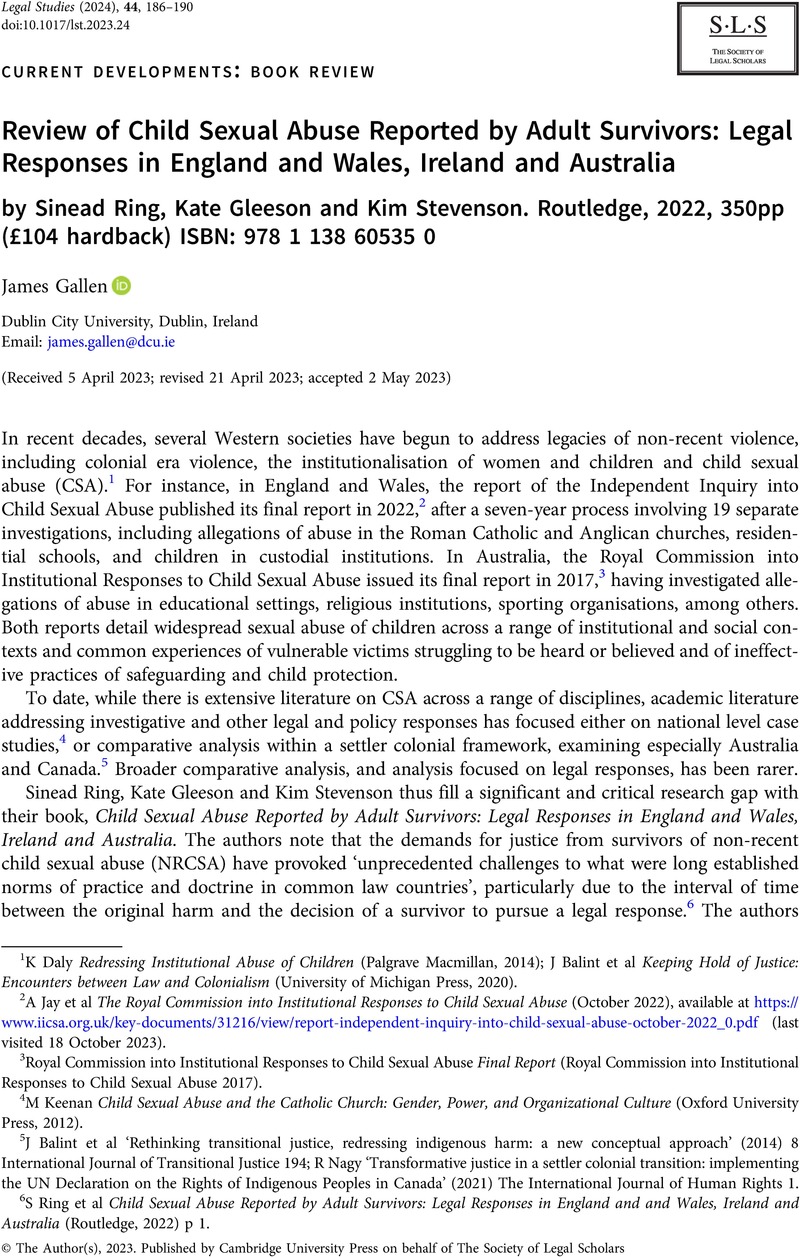No CrossRef data available.
Published online by Cambridge University Press: 23 November 2023

1 Daly, K Redressing Institutional Abuse of Children (Palgrave Macmillan, 2014)CrossRefGoogle Scholar; Balint, J et al Keeping Hold of Justice: Encounters between Law and Colonialism (University of Michigan Press, 2020)CrossRefGoogle Scholar.
2 A Jay et al The Royal Commission into Institutional Responses to Child Sexual Abuse (October 2022), available at https://www.iicsa.org.uk/key-documents/31216/view/report-independent-inquiry-into-child-sexual-abuse-october-2022_0.pdf (last visited 18 October 2023).
3 Royal Commission into Institutional Responses to Child Sexual Abuse Final Report (Royal Commission into Institutional Responses to Child Sexual Abuse 2017).
4 Keenan, M Child Sexual Abuse and the Catholic Church: Gender, Power, and Organizational Culture (Oxford University Press, 2012)Google Scholar.
5 Balint, J et al ‘Rethinking transitional justice, redressing indigenous harm: a new conceptual approach’ (2014) 8 International Journal of Transitional Justice 194CrossRefGoogle Scholar; Nagy, R ‘Transformative justice in a settler colonial transition: implementing the UN Declaration on the Rights of Indigenous Peoples in Canada’ (2021) The International Journal of Human Rights 1Google Scholar.
6 Ring, S et al Child Sexual Abuse Reported by Adult Survivors: Legal Responses in England and and Wales, Ireland and Australia (Routledge, 2022) p 1CrossRefGoogle Scholar.
7 Ibid, pp 133–134.
8 Ibid, p 54.
9 Ibid, p 55–57.
10 Ibid, p 115.
11 Mutua & Others v The Foreign and Commonwealth Office [2012] EWHC 2678 (QB) (5 October 2012).
12 Balint, J ‘The “Mau Mau” legal hearings and recognizing the crimes of the British colonial state: a limited constitutive moment’ (2016) 3 Critical Analysis of Law 261 at 264–265CrossRefGoogle Scholar.
13 Ibid, at 265.
14 C McGlynn and N Westmarland ‘Kaleidoscopic justice: sexual violence and victim-survivors’ perceptions of justice’ (2019) 28 Social & Legal Studies 179.
15 McAlinden, A-M and Naylor, B ‘Reframing public inquiries as “procedural justice” for victims of institutional child abuse: towards a hybrid model of justice’ (2016) 38 Sydney Law Review 277Google Scholar; Daly, above n 1; Lundy, P ‘“I just want justice”: the impact of historical institutional child-abuse inquiries from the survivor's perspective’ (2020) 55 Éire-Ireland 252CrossRefGoogle Scholar.
16 Ring et al (n 6) p 164.
17 Powell, A et al Rape Justice: Beyond the Criminal Law (Palgrave Macmillan, 2015)CrossRefGoogle Scholar.
18 Royal Commission into Institutional Responses to Child Sexual Abuse Redress and Civil Litigation Report (Royal Commission into Institutional Responses to Child Sexual Abuse, 2015) p 112 https://www.childabuseroyalcommission.gov.au/sites/default/files/file-list/final_report_-_redress_and_civil_litigation.pdf (last accessed 18 October 2023); A Jay et al ‘The Anglican church safeguarding in the Church of England and the Church in Wales’ (IICSA) p 64.
19 Wright, K ‘Remaking collective knowledge: an analysis of the complex and multiple effects of inquiries into historical institutional child abuse’ (2017) 74(10) Child Abuse & Neglect 10CrossRefGoogle ScholarPubMed.
20 Ring et al (n 6) p 290.
21 Smart, C ‘A history of ambivalence and conflict in the discursive construction of the “child victim” of sexual abuse’ (1999) 8 Social & Legal Studies 391CrossRefGoogle Scholar.
22 Ring et al (n 6) p 307.